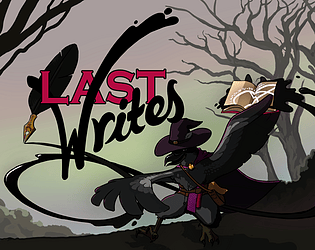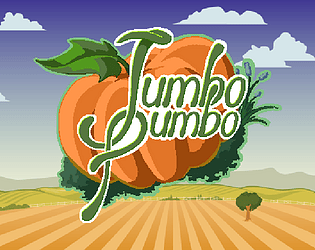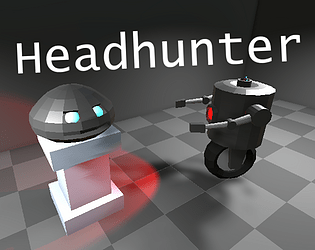I like how the music is dynamic and matches up with all the enemies, and it definitely complimented the gameplay for me. The dream-based synopsis is also neat. Needing to shoot to the beat enhanced the game for me due to how it played well with everything else. I did miss quite a few beats, and based on the game description, that might be a technical issue due to me playing the web build (although it could also be a skill issue on my part). I am glad that it's not too punishing if you miss the beat, so that didn't detract too much at all for me. My one suggestion would be to make the shoot button something other than "space", since I find the "space" key to be one of the more annoying keys to press repeatedly.
patowen
Creator of
Recent community posts
Great game! The fixed time limit for the time loops definitely help solidify the puzzle mechanics, allowing for a good variety of tricky but not frustrating puzzles. Overall, I enjoyed playing through all the levels. If this game is expanded upon, it would probably make sense to add some quality of life features, like the ability to restart a particular loop, go back a loop to correct something, or potentially something fancy like the ability to retry a previous loop without having to redo the loops after it. For the levels this game has right now, though, such abilities are certainly not needed.
I am glad that the game lets me preview a level and decide when I'm ready to start the next loop, giving me time to think.
I like the blue field as a way to add a kind of restriction to the interact-with-past-version platform game mechanic. I did need to restart some levels a few times due to not knowing which buttons affected which doors and starting to have more clones on screen than I could handle, but I would say that this game has solid mechanics. My main suggestion would be to have a way to tell which buttons corresponded to which doors, a way to see the whole level at once, and a way to reset without leaving a clone (since it's already possible to do that in certain areas by dying).
This game had neat visuals/effects, and the puzzle mechanics of getting the two robots to work together were pretty neat. I ended up playing until the lava level. My main suggestion would be to try to streamline the mechanics to make the puzzles faster to execute once the player comes up with a solution. For instance, I believe I would prefer if switching players were instant (or had a 1-second animation), and I do wonder if there's a way to make deaths caused by platforming mistakes to be less punishing, as the lava level caused me some frustration.
Interesting concept. I do like how it illustrates the unreliability of eyewitness testimony. I was a bit confused at first, as I didn't read the instructions properly and just walked home without interacting with any other controls and still got a very high score, but I'm sure this could become quite a tricky game with some extra tuning.
I liked the power scaling in this game and eventually (after a second playthrough) learned how to reliably dodge all attacks from the final boss. As far as I can tell, I don't lose any progress when I die, but I do wonder if there's a challenge in beating it in as few deaths as possible. I do unfortunately crash after pressing the button after winning the game, so there might be extra content I'm missing.
I definitely loved the atmosphere of this game. I did get tripped up thinking that there were only two story books (three total books), causing me to end up doing a bit of brute forcing. The owls were cute, and the narrative was quite mysterious. I do wonder what other kinds of puzzles would have been able to fit well with the narrative.
No worries. This might be specific to my computer. It's odd, as even when I am in the pixel-perfect center of the object with the label "BOARD" above it and press "E" early in the loop (which I believe one of the initial sheriff dialog options tells me to do), nothing seems to happen.
EDIT: With the help of a macro that spams the E key, I was able to beat the game. Definitely an interesting concept, taking advantage of information so that the 15 seconds are enough. I'd be interested to see how this concept could be expanded upon. (slight SPOILER alert: I can imagine a trickier puzzle that could be added that would require you to use multiple echos in a single loop to get all the materials you need, although such a puzzle could be frustrating if you fail the maneuver and have to do the whole setup again.)
I like the artstyle of this game! The red field is a cool mechanic for me to have to be deliberate in choosing where to place my echos. Some of the later levels did get a little frustrating, partially because I couldn't easily predict what targets enemies would try to shoot. I believe the rules are something like "closest enemy target", although I'm not 100% sure.
This is an interesting twist on the classic Snake game, it's interesting how colliding with yourself is a win condition instead of a lose condition. I am wondering what the intended way of beating this is, though, as it seems to be possible to win relatively easily by eating one or two apples and forming a tight loop.
I want to be able to try this game, but I've tried for 10 minutes or so and was unsuccessful in interacting with a single object. Is there a specific place I should stand or button to hold down to make progress? I see that several people were able to make much more progress than me, and I can't tell what I'm doing wrong, and I'm wondering if my computer is different somehow. Please can you provide a walkthrough of how to interact with the first object, and I can see if I'm able to do that?
It's cool how the same obstacles come up again and again, and you need to manage your resources to keep them at bay, which definitely makes the game quite hectic. I also like that the first 3 obstacles help serve as a tutorial. Unfortunately, I was unable to get a score above 20, as I had trouble finding the right spell and reading the level at the same time, especially when the same spell appears repeatedly in the queue. I'm definitely impressed that someone was able to reach 110 points.
Interesting concept. The game fortunately started out simple enough for me to get the hang of the rules before it got too complicated, although I definitely went on the wrong path a few times. I definitely find it cool that all paths lead back to the start. I made it up to 1703. One suggestion would be to consider making the train move automatically, possibly with a button to slow it down if you need time to think (just so that you don't have to spend most of the game holding space).
Quite a challenging game. The sweet spot mechanic of needing to hold a direction for a certain amount of time to maximize height was an interesting mechanic. I ended up playing up to a score of 7630. My main suggestion would be to increase consistency, since losing upward momentum when colliding with a vertical wall can be frustrating at times.
This was quite a charming game! It took a bit of time for me to make any progress on it, but I was able to get the gist of it after a few attempts. My main recommendation would be to increase the size of the hitbox of the small food pellets, since that can be a source of difficulty especially at the beginning of the game where you're very small. It might also be good to be able to tell what's bigger or smaller than you without having to just estimate it by eye.
This is an interesting concept, a bit like tower defense but where you get to move the tower you're defending upwards (and you can control one turret at a time for additional defense). My main recommendation to make the game more fun would be to add tricky decisions the player needs to make. One possibility would be turrets with strengths and weaknesses against different enemy types, and/or occasional waves of enemies that can't be defeated quickly enough without manually controlling some turrets (and possibly swapping between turrets to get the different enemy types).
I definitely like the twist on the dolly-zoom effect, where instead of the camera going in and out, the object becomes bigger and smaller. I'm curious if there would be a way to make "objects appearing the same size while growing and shrinking them" into more of a core mechanic. The danger is that without providing a reason for this kind of zooming, it could become tedious to repeatedly grow and shrink objects to solve the puzzles.
Quite an interesting take on the theme! I do like how you get to essentially hear how well you did instead of just seeing a number on the screen. For the piano, for placing the keys, I think it would have been more intuitive if the length and horizontal location of the keys were decided separately. As for the latter, it could be decided discretely, choosing where the black key pattern starts.
Wow, the turn timer is brutal. This was quite a fun and frantic game, trying to take care of all of the threats while hoping they wouldn't make you too weak to keep dealing with them. I especially enjoy that you can make a comeback even when the board gets very small. It seems like the thing that overwhelmed me at the end was the sheer enemy count (making me die at a score of 2030). I do wonder whether it's sometimes worth letting an enemy cut the board to avoid a downgrade, but my first guess would be that it almost never is.
Fun and simple game! I do enjoy the growth and shrink mechanic, as I haven't seen it since I played Specter Spelunker Shrinks a long time ago. I do like how you sometimes need to plan ahead and look at part of the level while you're big to plan your route. I also learned that there's a secret 7th level that you can only reach from the level select screen (although I don't know whether that's intentional).
Fun and simple game! I do enjoy the growth and shrink mechanic, as I haven't seen it since I played Specter Spelunker Shrinks a long time ago. I do like how you sometimes need to plan ahead and look at part of the level while you're big to plan your route. I also learned that there's a secret 7th level that you can only reach from the level select screen (although I don't know whether that's intentional).
Quite a fun (but tricky) little game. I can see the idea is to "build" to "scale" over obstacles, although I do wonder if there's a creative way to play with the concepts of large and small within this game as well.
My main suggestion would be to add different types of difficulty to the game and reduce the parts of the difficulty that can feel artificial. For instance, if the blocks you placed were made larger, the timing window to jump on them wouldn't be as tight, and a single block would be able to turn a jump from being impossible to being easy (instead of being barely possible). This would leave room for more of the other types of difficulty, such as puzzling out how to beat a level or having to multitask to deal with multiple threats at the same time.
This game is very well polished! I like that I don't lose instantly if I make a single mistake, no matter how large the collapse is (although a large enough collapse can be pretty bad, since it prevents me from reaching any hearts for a while). I also like that it displays a helpful grid to help me line things up (until I mess up and make everything diagonal).
I like how which enemies are harmless change over time, keeping you on your toes. This has a good potential to bring about a risk/reward element where you have to choose between getting rid of the dangerous enemies vs trying to upgrade your bullet. To further improve the game, my suggestion would be finding ways to improve the skill ceiling, requiring players to figure out strategies for improving their score. One approach to doing this would be reduce the luck factor, such as ensuring that enemies do not spawn too close to you. Another approach would be to increase strategy by making it possible to lose the opportunity to shoot a mushroom that would upgrade your bullet (if you ignore that mushroom for a while).
The math-themed puzzle got me confused for quite a while, as I was wondering whether the gimmick was related to the operator on the blackboard not actually being a "+" sign. My main criticism is that only the original door ever opens, and I had hoped that the other puzzles would serve as clues for the initial room rather than being standalone.
I did like the sneaky message in the math room.
This game feels quite solid to me. The door effect is quite cool (although I find myself slightly missing the transition zone sometimes). My main suggestions would be quality of life features such as indicators of your current food item, making the range of your weapons and pickaxe more obvious (to avoid an unintentional feeling of randomness), and allowing some movement (possibly slower) while attacking or mining.




